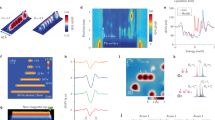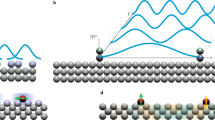Abstract
The invention of scanning probe microscopy revolutionized the way electronic phenomena are visualized1. Whereas present-day probes can access a variety of electronic properties at a single location in space2, a scanning microscope that can directly probe the quantum mechanical existence of an electron at several locations would provide direct access to key quantum properties of electronic systems, so far unreachable. Here, we demonstrate a conceptually new type of scanning probe microscope—the quantum twisting microscope (QTM)—capable of performing local interference experiments at its tip. The QTM is based on a unique van der Waals tip, allowing the creation of pristine two-dimensional junctions, which provide a multitude of coherently interfering paths for an electron to tunnel into a sample. With the addition of a continuously scanned twist angle between the tip and sample, this microscope probes electrons along a line in momentum space similar to how a scanning tunnelling microscope probes electrons along a line in real space. Through a series of experiments, we demonstrate room-temperature quantum coherence at the tip, study the twist angle evolution of twisted bilayer graphene, directly image the energy bands of monolayer and twisted bilayer graphene and, finally, apply large local pressures while visualizing the gradual flattening of the low-energy band of twisted bilayer graphene. The QTM opens the way for new classes of experiments on quantum materials.
This is a preview of subscription content, access via your institution
Access options
Access Nature and 54 other Nature Portfolio journals
Get Nature+, our best-value online-access subscription
$29.99 / 30 days
cancel any time
Subscribe to this journal
Receive 51 print issues and online access
$199.00 per year
only $3.90 per issue
Buy this article
- Purchase on Springer Link
- Instant access to full article PDF
Prices may be subject to local taxes which are calculated during checkout




Similar content being viewed by others
Data availability
The data shown in this paper are provided with this paper. Additional data that support the plots and other analysis in this work are available from the corresponding author upon request.
References
Binnig, G. & Rohrer, H. Scanning tunneling microscopy. Surf. Sci. 152–153, 17–26 (1985).
Bian, K. et al. Scanning probe microscopy. Nat. Rev. Methods Primers 1, 36 (2021).
Bistritzer, R. & MacDonald, A. H. Moiré bands in twisted double-layer graphene. Proc. Natl Acad. Sci. USA 108, 12233–12237 (2011).
Cao, Y. et al. Unconventional superconductivity in magic-angle graphene superlattices. Nature 556, 43–50 (2018).
Cao, Y. et al. Correlated insulator behaviour at half-filling in magic-angle graphene superlattices. Nature 556, 80–84 (2018).
Eisenstein, J. P., Gramila, T. J., Pfeiffer, L. N. & West, K. W. Probing a two-dimensional Fermi surface by tunneling. Phys. Rev. B 44, 6511–6514 (1991).
Murphy, S. Q., Eisenstein, J. P., Pfeiffer, L. N. & West, K. W. Lifetime of two-dimensional electrons measured by tunneling spectroscopy. Phys. Rev. B 52, 14825–14828 (1995).
Auslaender, O. M. et al. Tunneling spectroscopy of the elementary excitations in a one-dimensional wire. Science 295, 825–828 (2002).
Britnell, L. et al. Resonant tunnelling and negative differential conductance in graphene transistors. Nat. Commun. 4, 1794 (2013).
Mishchenko, A. et al. Twist-controlled resonant tunnelling in graphene/boron nitride/graphene heterostructures. Nat. Nanotechnol. 9, 808–813 (2014).
Fallahazad, B. et al. Gate-tunable resonant tunneling in double bilayer graphene heterostructures. Nano Lett. 15, 428–433 (2015).
Wallbank, J. R. et al. Tuning the valley and chiral quantum state of Dirac electrons in van der Waals heterostructures. Science 353, 575–579 (2016).
Jang, J. et al. Full momentum- and energy-resolved spectral function of a 2D electronic system. Science 358, 901–906 (2017).
Prasad, N. et al. Quantum lifetime spectroscopy and magnetotunneling in double bilayer graphene heterostructures. Phys. Rev. Lett. 127, 117701 (2021).
Lin, K. et al. Emergence of interlayer coherence in twist-controlled graphene double layers. Phys. Rev. Lett. 129, 187701 (2022).
Seo, Y. et al. Subband-resolved momentum-conserved resonant tunneling in monolayer graphene/h-BN/ABA-trilayer graphene small-twist-angle tunneling device. Appl. Phys. Lett. 120, 083102 (2022).
Koren, E. et al. Coherent commensurate electronic states at the interface between misoriented graphene layers. Nat. Nanotechnol. 11, 752–757 (2016).
Chari, T., Ribeiro-Palau, R., Dean, C. R. & Shepard, K. Resistivity of rotated graphite–graphene contacts. Nano Lett. 16, 4477–4482 (2016).
Ribeiro-Palau, R. et al. Twistable electronics with dynamically rotatable heterostructures. Science 361, 690–693 (2018).
Yang, Y. et al. In situ manipulation of van der Waals heterostructures for twistronics. Sci. Adv. 6, eabd3655 (2020).
Hu, C. et al. In-situ twistable bilayer graphene. Sci. Rep. 12, 204 (2022).
Frisenda, R. et al. Recent progress in the assembly of nanodevices and van der Waals heterostructures by deterministic placement of 2D materials. Chem. Soc. Rev. 47, 53–68 (2018).
Bistritzer, R. & MacDonald, A. H. Transport between twisted graphene layers. Phys. Rev. B 81, 245412 (2010).
Mele, E. J. Commensuration and interlayer coherence in twisted bilayer graphene. Phys. Rev. B 81, 161405 (2010).
Damascelli, A., Hussain, Z. & Shen, Z.-X. Angle-resolved photoemission studies of the cuprate superconductors. Rev. Mod. Phys. 75, 473–541 (2003).
Zhang, H. et al. Angle-resolved photoemission spectroscopy. Nat. Rev. Methods Primers 2, 54 (2022).
Feenstra, R. M., Jena, D. & Gu, G. Single-particle tunneling in doped graphene-insulator-graphene junctions. J. Appl. Phys. 111, 043711 (2012).
Elias, D. C. et al. Dirac cones reshaped by interaction effects in suspended graphene. Nat. Phys. 7, 701–704 (2011).
Lopes dos Santos, J. M. B., Peres, N. M. R. & Castro Neto, A. H. Continuum model of the twisted graphene bilayer. Phys. Rev. B 86, 155449 (2012).
Carr, S., Fang, S., Jarillo-Herrero, P. & Kaxiras, E. Pressure dependence of the magic twist angle in graphene superlattices. Phys. Rev. B 98, 085144 (2018).
Yankowitz, M. et al. Dynamic band-structure tuning of graphene moiré superlattices with pressure. Nature 557, 404–408 (2018).
Yankowitz, M. et al. Tuning superconductivity in twisted bilayer graphene. Science 363, 1059–1064 (2019).
Chittari, B. L., Leconte, N., Javvaji, S. & Jung, J. Pressure induced compression of flatbands in twisted bilayer graphene. Electron. Struct. 1, 015001 (2018).
Chebrolu, N. R., Chittari, B. L. & Jung, J. Flat bands in twisted double bilayer graphene. Phys. Rev. B 99, 235417 (2019).
Lee, C., Wei, X., Kysar, J. W. & Hone, J. Measurement of the elastic properties and intrinsic strength of monolayer graphene. Science 321, 385–388 (2008).
Ares, P. et al. Tunable graphene electronics with local ultrahigh pressure. Adv. Funct. Mater. 29, 1806715 (2019).
Chen, G. et al. Evidence of a gate-tunable Mott insulator in a trilayer graphene moiré superlattice. Nat. Phys. 15, 237–241 (2019).
Zhou, H., Xie, T., Taniguchi, T., Watanabe, K. & Young, A. F. Superconductivity in rhombohedral trilayer graphene. Nature 598, 434–438 (2021).
Zhou, H. et al. Half- and quarter-metals in rhombohedral trilayer graphene. Nature 598, 429–433 (2021).
Shi, Y. et al. Electronic phase separation in multilayer rhombohedral graphite. Nature 584, 210–214 (2020).
Kennes, D. M. et al. Moiré heterostructures as a condensed-matter quantum simulator. Nat. Phys. 17, 155–163 (2021).
Mak, K. F. & Shan, J. Semiconductor moiré materials. Nat. Nanotechnol. 17, 686–695 (2022).
Yabuki, N. et al. Supercurrent in van der Waals Josephson junction. Nat. Commun. 7, 10616 (2016).
Farrar, L. S. et al. Superconducting quantum interference in twisted van der Waals heterostructures. Nano Lett. 21, 6725–6731 (2021).
Zhao, S. Y. F. et al. Emergent interfacial superconductivity between twisted cuprate superconductors. Preprint at https://arxiv.org/abs/2108.13455 (2021).
Acknowledgements
We thank P. Jarillo-Herrero, A. Kanigel, Y. Ronen, H. Steinberg and U. Zondiner for useful discussions and comments to the manuscript. Work was supported by the Leona M. and Harry B. Helmsley Charitable Trust grant, the Rosa and Emilio Segre Research Award, the ERC-Cog grant (See-1D-Qmatter, no. 647413) and the BSF grant (no. 2020260).
Author information
Authors and Affiliations
Contributions
A.I., J.B., J.X. and S.I. designed the experiment. A.I., J.B. and J.X. built the setup, fabricated the devices and performed the experiments. A.I., J.B., J.X. and S.I. analysed the data. J.X., B.Y., Y.O., A.S. and E.B. wrote the theoretical models. K.W. and T.T. supplied the hBN crystals. A.I., J.B., J.X., A.S., E.B. and S.I. wrote the manuscript with input from other authors.
Corresponding author
Ethics declarations
Competing interests
The authors declare no competing interests.
Peer review
Peer review information
Nature thanks Raymond Ashoori and the other, anonymous, reviewer(s) for their contribution to the peer review of this work.
Additional information
Publisher’s note Springer Nature remains neutral with regard to jurisdictional claims in published maps and institutional affiliations.
Supplementary information
Supplementary Information
This file contains Supplementary Sections 1–14, Figs. 1–24 and additional references.
Supplementary Video 1
Imaging TBG bands under pressure.
Supplementary Video 2
Tracing the TBG flat bands with the Dirac point of MLG.
Supplementary Video 3
Tracing the MLG probe bands using the TBG Dirac point.
Supplementary Video 4
Energy-momentum-conserving states in MLG–MLG junction versus twist angle.
Supplementary Video 5
Energy-momentum-conserving states in MLG–TBG junction versus bias.
Rights and permissions
Springer Nature or its licensor (e.g. a society or other partner) holds exclusive rights to this article under a publishing agreement with the author(s) or other rightsholder(s); author self-archiving of the accepted manuscript version of this article is solely governed by the terms of such publishing agreement and applicable law.
About this article
Cite this article
Inbar, A., Birkbeck, J., Xiao, J. et al. The quantum twisting microscope. Nature 614, 682–687 (2023). https://doi.org/10.1038/s41586-022-05685-y
Received:
Accepted:
Published:
Issue Date:
DOI: https://doi.org/10.1038/s41586-022-05685-y
This article is cited by
-
Probing the tunable multi-cone band structure in Bernal bilayer graphene
Nature Communications (2024)
-
Tuning commensurability in twisted van der Waals bilayers
Nature (2024)
-
Heavy quasiparticles and cascades without symmetry breaking in twisted bilayer graphene
Nature Communications (2023)
-
A twist in the bid to probe electrons in solids
Nature (2023)
-
0D van der Waals interfacial ferroelectricity
Nature Communications (2023)
Comments
By submitting a comment you agree to abide by our Terms and Community Guidelines. If you find something abusive or that does not comply with our terms or guidelines please flag it as inappropriate.



